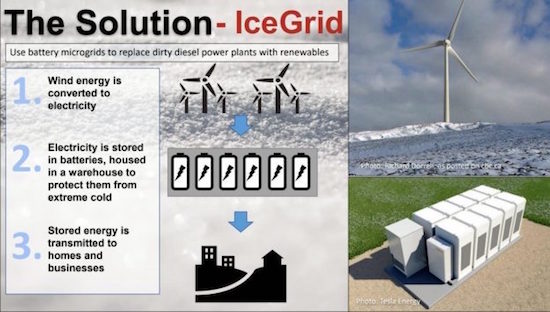
Microgrid Knowledge
 Remote communities across Canada’s far northern provinces rely on diesel and bunker-fuel generators for electricity. A dramatic change for the better may be in store – if efforts to fully realise a wind power-battery energy storage microgrid come to fruition.
Remote communities across Canada’s far northern provinces rely on diesel and bunker-fuel generators for electricity. A dramatic change for the better may be in store – if efforts to fully realise a wind power-battery energy storage microgrid come to fruition.
The conceptual designers of IceGrid – a university marine research scientist, a city councilor and business analyst, and an entrepreneur – recently won the first prize at the CanInfra Challenge, an open competition that sought to bring forth ideas from local community residents deemed to have the greatest potential to transform lives and livelihoods for people living throughout Canada.
Energy – how best to produce and distribute it – looms large for Canadian residents, businesses and communities. That’s especially true in remote towns and cities in Canada’s far north, where electricity rates are the highest in the nation and quality of service suffers.
Their reliance on diesel generating stations also comes with costs to human and environmental health and quality, said IceGrid team member Brett Favaro, a marine research scientist at Memorial University of Newfoundland’s Fisheries and Marine Institute.
IceGrid and the CanInfra Challenge
CanInfra Challenge judges awarded the IceGrid team first prize for their proposal to replace diesel-fuel generating plants with a grid-connected, wind power-battery energy storage microgrid, first in Iqaluit, the capital of Nunavut, and then throughout the northwestern Canadian province.
Microgrid Knowledge spoke with Favaro and Keith Halliday, director of the BCG (Boston Consulting Group) Center for Canada’s Future, which organized the CanInfra Challenge competition and conference, to learn more.
CanInfra came about as a result of discussions between Halliday and BCG colleague and partner Kilian Berz (who happens to serve as Prime Minister Justin Trudeau’s special advisor on investment), along with leaders of Canadian companies who wound up sponsoring CanInfra along with BCG, Halliday explained.
“We felt that it was important to Canada’s future to elevate the national discussion on infrastructure, in particular ‘transformational’ infrastructure that can have a step-change impact on our economy, environment and society. So we decided to have two conferences book-ending a national infrastructure ideas contest open to all but focused on university students,” he said.
Favaro and fellow IceGrid concept developers Dave Lane and Brandon Copeland started working on their CanInfra presentation in January. Lane is a business analyst and St. John’s city councilor. Copeland, an entrepreneur, also lives and works in St. John’s.
“IceGrid is a concept – that you start with the first principle that electricity generation should not depend on non-renewable energy.
“We brainstormed a number of ideas but settled on IceGrid because reducing Canada’s dependence on diesel to support off-grid communities would generate tremendous savings, provide opportunity for communities whose growth is constrained by a lack of available, affordable electricity, and would move Canada and the world along in our shared goal of ‘decarbonising’ the world’s electricity generation systems,” Favaro explained in an interview.
The resulting IceGrid concept the trio proposed at CanInfra would couple wind power generation with enough battery-based energy storage to meet all of the power needs in the provincial capital city of Iqalvit’s for 24 hours. “So, in a sense, it would be a mega-microgrid,” he said.
Transforming lives and livelihoods in Canada’s far northern provinces
Reliance on diesel and bunker-fuel generators for electricity poses varied challenges in Nunavit and across isolated communities throughout Canada’s northern provinces. Prominent among them are the costs and price volatility of diesel or bunker fuel, operating and maintenance expenses, and the deleterious effects on human and environmental health.
“Right now, these communities are entirely dependent on diesel. Procurement and distribution of fuel is costly, even when you exclude social and health costs of diesel emissions. Operation and maintenance of diesel plants is also very expensive. Wind energy, and storage systems, by contrast, are much cheaper to operate and maintain, as described in a wide swatch of published literature on the topic,” Favaro said.
Microgrid benefits include energy reliability, energy accessibility, energy independence, and energy cost optimization. Download the new white paper from Schneider Electric that explores the benefits microgrids can provide and supplies examples of relevant microgrid projects.
Halliday offered his impression of IceGrid’s proposal.
“I can’t speak for the judges, but for me IceGrid was an ‘impactful’ idea since it could have an enormous transformational impact on Northern Canada, a vast area where energy costs are very high and a real inhibitor of economic activity, cost of living for Canadians and delivering social and government programs.
“The team also had a punchy live presentation and engaged effectively with the judges during the Q&A,” he told Microgrid Knowledge.
Looking forward, the BCG Center is working to connect the IceGrid and other prize-winning teams with private and public sector institutions interested in their ideas. It’s too early in the process to offer anything more in the way of details, Halliday said.
Much remains to be done if the IceGrid concept is to be realized, Favaro noted. “To be clear: We do not have a final design. What we presented was strictly a concept, as it was an idea-generation competition. So a substantial amount of work remains to turn this pitch into a project.”
This article was originally published on Microgrid Knowledge. Republished here with permission.


